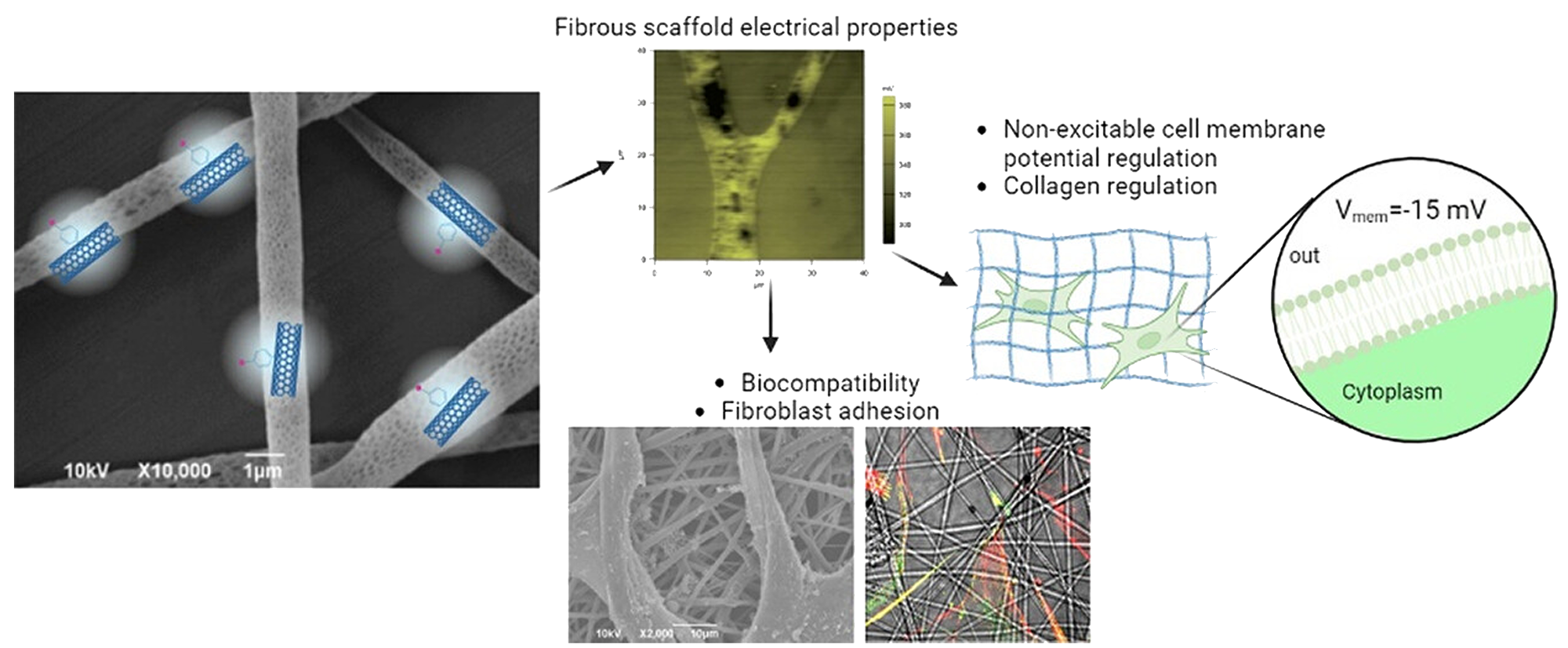Chemical Sciences
Chemically modified nanocomposite materials for Biomedical applications
Research Activity
Carbon nanostructures (CNS) such as carbon nanotubes (CNT), Graphene and Carbon Nanohorns, which are made up of extended sp2-hybridized carbon networks, are largely employed as nanofillers for polymer phases to obtain polymer-based nanocomposites (PNC). Following their inclusion, the polymer matrices are often improved in many ways, such as enhanced electrical and thermal conductivity, increased stability, and mechanical robustness. The chemical functionalization of the external CNS surfaces with organic substituents is often a key tool for their effective and homogeneous incorporation within a polymer phase, avoiding the formation of aggregates, which can lower the performance of the final material. These CNS-based PNCs can be used as scaffolds for tissete engineering. We demonstrated the possibility of boosting human neuronal cells growth/differentiation on a nanocomposite free-standing scaffold obtained by efficiently dispersing soluble organic derivatives of CNT in a poly-L-lactic acid (PLLA) matrix. The electrical resistance of the nanocomposite scaffold resulted more than one order of magnitude lower than that of a pure PLLA scaffold. Cells showed better adhesion to the CNT-PLLA scaffold in comparison with pure PLLA and, in addition, they presented a higher total neurite length. Scanning electron microscopy (SEM) images of cells cultured onto the PNC scaffold show an evidently healthy morphology and the outgrowth of neurites attaching to the scaffold surface, with intimate contact between this last one and the neuronal membrane. As a rational extension of this concept, we obtained a nanofibrous matrix, via electrospinning a CNT-PLLA nanocomposite solution, as a biocompatible scaffold for neuronal growth, aimed at better mimicking the extracellular matrix. Indeed, by using this scaffold as support for cells growth, the extension of neurites along the direction of the nanofibers was evidenced.
Electrostatic fields generated at the interface between cells and scaffold might favor cell growth by tuning their membrane potential.
The inclusion of functionalized CNT in the insulating PLLA matrix resulted in differences in the surface potential of the fibers. SEM, immunocytochemistry, Rt-qPCR, and electrophysiology revealed that fibroblasts grown on PLA/MWCNT reached a healthier state as compared to pure PLLA.
Expertise
Organic functionalization of carbon nanotubes and graphene through different approaches, including covalent linking, endohedral encapsulation for nanotubes (peapods) and supramolecular (non-covalent) exohedral interactions. Characterization through Raman and IR spectroscopy, UV-vis-NIR adsorption spectroscopy, fluorescence spectroscopy, dynamic light scattering (DLS), thermal gravimetric analysis (TGA).

Scanning electron microscopy (a, b) and optical microscopy (c) images of cells cultured onto the PNC scaffold [Carbon 2015, 95, 725–730.]

Functionalized CNT favor fibroblast growth by tuning the cell membrane potential, as evidenced by SEM, Kelvin probe and confocal microscopy images [ACS Appl. Mater. Interfaces 2024, 16, 3093-3105.]
Publications
ACS Appl. Mater. Interfaces 2024, 16, 3093-3105. (https://doi.org/10.1021/acsami.3c14527)
Nanomaterials 2021, 11, 404. (https://doi.org/10.3390/nano11020404)
Nanomaterials 2020, 10, 415. (https://dx.doi.org/doi:10.3390/nano10030415)
Mater. Chem. Phys., 2018, 214, 265-276. (http://dx.doi.org/10.1016/j.matchemphys.2018.04.042)
Nanomedicine 2016, 11, 1929-1946 (http://dx.doi.org/10.2217/nnm-2016-0150)
Nanomed.-Nanotechnol. Biol. Med. 2015, 11, 621-632. (http://dx.doi.org/10.1016/j.nano.2014.11.001)
Carbon 2015, 95, 725–730. (http://dx.doi.org/10.1016/j.carbon.2015.08.094)